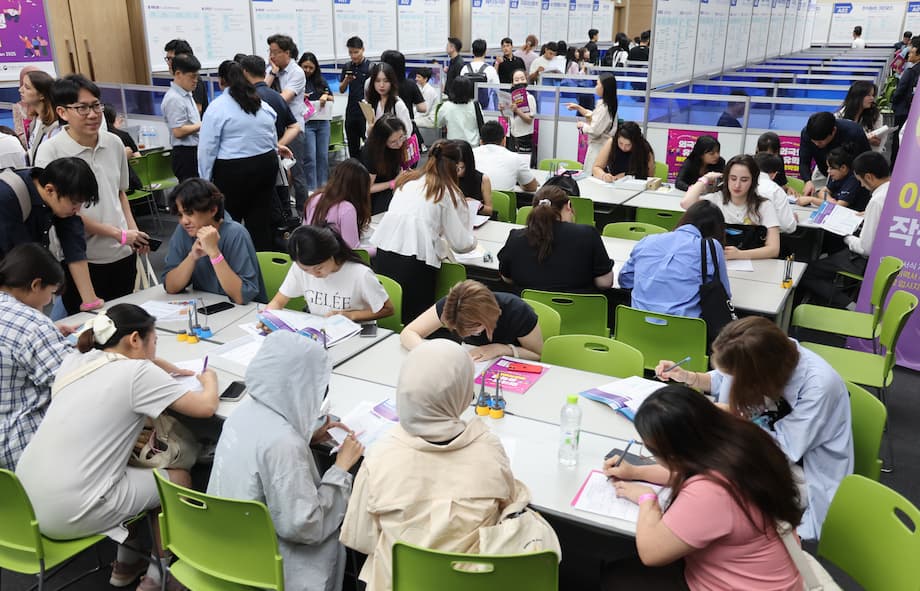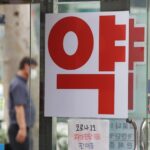A record enrollment reshapes Korean campuses
South Korea has crossed a threshold in global education. The number of international students enrolled at Korean universities and language institutes reached 305,329 in August, according to monthly figures from the Korea Immigration Service under the Ministry of Justice. It is the first time the country has topped 300,000, arriving two years ahead of the national target set by the Ministry of Education’s Study Korea 300K Project, which aimed for that figure by 2027.
The student body spans multiple routes into the country’s classrooms. Degree seekers on the D-2 visa make up the largest share at 225,769. A further 79,500 hold D-4-1 visas for Korean language training. A smaller cohort of 60 is listed under the D-4-7 category for foreign language training, a niche pathway that sits alongside the larger degree and language streams.
Origins are shifting as well. Vietnamese students now form the largest national group, with 107,807, or roughly 35.3 percent of all international students. Chinese students follow at 86,179. Other sizable communities include Uzbekistan with 18,155, Mongolia with 17,870 and Nepal with 15,515. The variety reflects both regional interest and active recruitment by Korean institutions across Asia.
The surge caps a four year climb: 163,699 students in 2021, 197,234 in 2022, 226,507 in 2023 and 263,775 in 2024. Earlier this summer, July enrollment reached 272,573, then accelerated again by August. Compliance numbers have moved in mixed directions. Newly identified undocumented stays among D-2 holders rose from 1,183 to 1,359 year on year, while those among D-4 holders fell from 1,841 to 1,347. These are small fractions of the total, yet they shape how universities and ministries fine tune oversight.
The headline number signals more than simple growth. It speaks to how campuses are changing, why student mobility patterns are tilting toward Asia and what kinds of support systems need to mature if Korea is to translate volume into long term educational and economic gains.
What is driving the surge
Several forces are converging. Government targets and friendlier rules have widened the pipeline. Demographic pressure at home has pushed universities to look abroad. Shifts in student flows, triggered by policy changes in other major destinations, are steering more applicants toward Asia. K culture, from music to media, adds a soft power pull that increases organic interest in studying in Korea.
Government targets and visa changes
The Education Ministry launched the Study Korea 300K Project in 2023, a whole of system push to lift international enrollment and position Korea as a competitive study destination. Government and industry actors have created new recruitment channels and simplified parts of the application path. Recent measures include lower financial thresholds for student visas, longer job seeking windows for graduates, larger on campus work allowances and expanded scholarships under national programs. Recruiters and universities have also piloted unified application gateways and global roadshows that connect students and agents directly with Korean campuses.
These changes do not act in isolation. The policy mix, coupled with better information in English and Korean about programs and life in Korea, reduces friction for applicants who might once have viewed the country as difficult to navigate. Early results are visible in the speed with which the 300,000 target has been met.
Demographics and university finances
Korea is confronting a steep decline in the college age population. The total fertility rate fell to 0.72 in 2023, well below the replacement level. Statistics on school age cohorts show a slide from about 7.89 million in 2020 to roughly 6.98 million this year, with projections that the count could drop near 4.66 million by 2040. Tuition has been largely frozen for more than a decade. The math puts financial pressure on institutions, especially outside the capital region. In a 2025 survey of university leaders by the Korean Council for University Education, 60.8 percent of presidents identified attracting and educating international students as a top strategic priority next only to financial aid.
International students help fill classrooms and, when well supported, can strengthen research output and industry links. That makes sustained recruitment a survival strategy for some schools, and a growth strategy for others with specialized programs that appeal to overseas applicants.
Shifts in global student flows
Policy resets in traditional destination countries have also changed the map. The United States still hosts the largest number of international students, with annual totals around one million in recent years, according to long running datasets from higher education bodies. Yet visa uncertainty, work rule changes and political headwinds have made the path less predictable for some applicants. Canada, Australia and Britain have tightened specific rules in cycles, complicating planning for families and agents.
Asian universities have capitalized by expanding English taught programs, building new labs and intensifying recruitment. Korea is part of that pivot. Some universities have even moved to accommodate students and scholars whose plans were disrupted elsewhere, signaling a focus on academic continuity and research ties. Those signals, combined with new work options after graduation, help explain why more students are choosing Korea now than at any time in the past.
Where students are coming from
Vietnam is the standout, now representing more than a third of all international students in Korea. China remains a large source, but its share has eased compared with a decade ago. Uzbekistan, Mongolia and Nepal are growing contributors, and networks in Southeast Asia and South Asia are expanding. The Ministry of Justice enrollment snapshot for August reflects this mix: 107,807 from Vietnam, 86,179 from China, 18,155 from Uzbekistan, 17,870 from Mongolia and 15,515 from Nepal.
Researchers tracking institutional data point to a clear trend. Ten years ago, many campuses relied heavily on a single country. Today, more universities report a broader spread of nationalities and a declining concentration of Chinese students. The number of home countries represented has risen from roughly 141 in 2014 to about 155 last year. Two year colleges have doubled their international footprint, diversifying beyond the capital area as local governments and schools coordinate recruitment.
The Vietnam story has its own drivers. Graduates see Korea as a bridge to advanced manufacturing, information technology and hospitality careers. The country to country economic relationship is deep, spanning trade, investment and labor entry channels. That familiarity lowers perceived risk for families and helps universities maintain pipelines through alumni, agents and partner institutions.
Vietnam rises, China realigns
Across many campuses, the share of Vietnamese nationals has increased quickly, while the dominance of Chinese cohorts has faded. That rebalancing reduces single country exposure in some programs. It also introduces new language and advising needs that differ by region. Admissions offices and international affairs teams are adjusting outreach materials, placement policies and parent communication to fit the new profile.
Broader mix across campuses
Even smaller or specialized campuses report a wider range of passports. At one international campus in Korea, administrators say international students have accounted for roughly 8 to 16 percent of total enrollment in recent years, with 123 international students on campus in spring 2024 and representation from Brazil, Canada, Germany, Italy, Morocco, Nepal, the Philippines, Russia, Thailand and the United States. That kind of mix, while still modest in scale, brings different academic expectations and support needs, prompting universities to redesign orientation and advising.
How universities are changing
The presence of international students is no longer confined to a handful of flagship schools. A government affiliated study found that 12 out of 389 universities and colleges saw international students exceed 20 percent of total enrollment last year, up from none a decade earlier. The middle bands are filling in too, with many more institutions reporting that 5 to 15 percent of their student body is from overseas.
Internationalization is visible in course catalogs, dormitory allocation, student life programming and career services. Many campuses now run targeted academic support for non native speakers, tutoring centers tuned to bilingual instruction and workshops that explain research ethics, internship rules and workplace culture in Korea. Cities and provincial governments partner with universities to host cultural festivals and job fairs that aim to knit visiting students into local life.
International branch campuses and joint programs are one part of the picture. For instance, one university’s Korea campus reports that international students are a meaningful share of enrollment, supported by structured pathways such as direct admission, semester abroad and global gateway programs. These setups often come with built in services that coordinate immigration advising, credit transfer and transnational campus moves.
Support models on campus
Support is evolving beyond paperwork. Universities describe a shift toward integrated services that combine immigration compliance, academic mentoring and social programming. Some have created dedicated departments for international cohorts, a model that can deliver focused coaching and early alerts when students struggle. The aim is to move from recruitment to retention and success, with stronger graduation outcomes and clearer routes into research or industry roles.
Quality and integration challenges
Rapid growth carries risks. Language proficiency remains a core constraint in classrooms taught in Korean or English. Universities are encouraged to set benchmarks such as TOPIK Level 3 for entry and Level 4 before graduation for Korean medium programs, yet those thresholds are not legal requirements. Schools retain autonomy in admissions, which can lead to uneven standards across departments.
Recent data shared by the Education Ministry indicates that only about one third of degree seeking international students had reached TOPIK Level 4 or higher. The share of students who presented qualifying English scores was much smaller. Combined, the figures suggest that a substantial number of undergraduates and graduate students may be trying to master coursework while still gaining language proficiency. Faculty report that this can complicate group work, assessments and academic integrity training if support is thin.
Officials note that while universities control admissions, the government can curb visa issuance to programs that repeatedly enroll underqualified students or fail to manage attendance and academic performance. Policymakers have also signaled a shift from headcount to outcomes, with incentives tied to completion rates, employment and regional contribution.
Song Ki-chang, chancellor of Sungsan Hyo University and honorary professor at Sookmyung Women’s University, cautions that recruitment alone does not capture the purpose of international education.
The fundamental purpose of international students is to learn about Korea. By gaining a deeper understanding of the country, they can become advocates for Korea abroad, helping to enhance its image and influence on the global stage even after they return home.
Moon Hyung-nam, a professor in the Division of Global Convergence at Sookmyung Women’s University, described how specialized departments can help students feel anchored.
At other departments, international students may not receive much direct support. But in the specialized department, the school can provide tailored support through mentoring and coaching, which helps students feel they are truly being supported by the university.
Compliance trends require continued attention. Newly identified undocumented stays among degree visa holders edged up in the latest comparison, while the figure for language training visa holders fell. Universities say tighter attendance tracking, clearer host family rules for language students and faster information sharing with immigration services have helped curb the latter. The degree stream is more complex, spanning longer study periods and greater variation in academic preparation.
Job prospects and retention
Keeping more graduates in Korea is a central policy goal. Survey data show that only about 35 percent of international graduates plan to seek employment in Korea, and roughly 40 percent do not intend to stay after graduation. The gap reflects language barriers, uneven recognition of foreign qualifications, and uncertainty about the path from a student visa to a stable work status.
To address this, agencies are expanding career programming. The National Institute for International Education has introduced employment briefings and career camps. The Education Ministry has outlined plans to collaborate with local governments on designated student zones that link recruitment with training and jobs in regional industries. Longer job search windows and clearer guidance on switching from study to work visas are part of the toolkit. Universities are building employer networks and alumni mentoring to improve placement.
Lawmaker Jin Sun-mi, who has pressed for reforms, frames the task in simple terms.
There is a clear need to strengthen entry criteria and provide expanded support so that foreign students can succeed academically, not just numerically fill seats.
A changing global market
Even at 305,329, Korea’s international student population is smaller than that of the United States, which has historically hosted more than a million foreign students each year, and smaller than Canada or Britain at their peaks. The direction of travel, however, is different. Korea is climbing from a lower base, fueled by policy reforms, institutional learning and cultural pull. The country now sits firmly among Asia’s leading study destinations, alongside Japan, Singapore and China, each with distinct strengths and visa regimes.
Sustaining momentum requires more than marketing. Students weigh academic quality, cost, housing, safety, work rights and post graduation prospects. That means consistent standards for language and admissions, transparent information about graduate outcomes and predictable pathways into skilled employment. Researchers and policy advisers have urged universities to set diversity goals to avoid overreliance on one source country and to track the student experience with data that go beyond enrollment. Tools that assess internationalization, student support and employability are beginning to emerge in Korea to give applicants and schools a common yardstick.
For Korea, the milestone marks a turning point. International students are no longer peripheral. They are reshaping classrooms, research teams and local economies. Converting this influx into lasting benefits will depend on how well campuses and governments match quantity with quality, from admissions through employment.
Key Points
- International student enrollment in Korea reached 305,329 in August, the first time above 300,000.
- The Study Korea 300K target, set for 2027, has been met ahead of schedule.
- D-2 degree visas account for 225,769 students, with 79,500 on D-4-1 language training visas.
- Vietnam is now the largest source country with 107,807 students, followed by China at 86,179.
- Enrollment has risen four years in a row, from 163,699 in 2021 to 263,775 in 2024, then 305,329 by August 2025.
- Universities with more than 20 percent foreign students increased to 12 institutions last year.
- Researchers report a broader mix of nationalities across campuses, though reliance on Vietnam is rising.
- Language proficiency is a key challenge, with only about one third at TOPIK Level 4 or higher.
- Policy shifts include longer job search windows, expanded work allowances and new career programs.
- Officials and experts call for stronger entry standards, better support and clearer routes from study to work.




